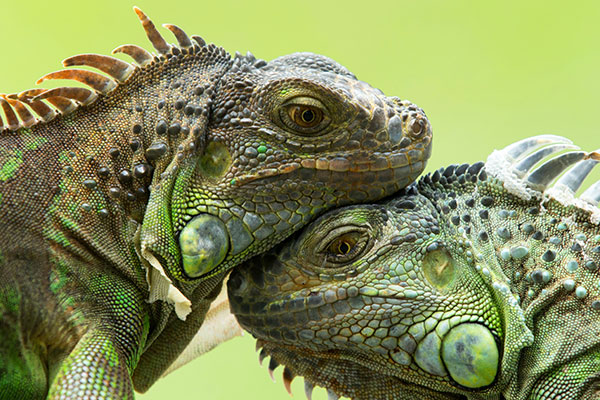Keeping Green Iguanas Out of the Garden
Key News ContributorOctober 25, 2017

How Do We Keep Green Iguanas Out of Our Garden?
 Subject: Invasive Green Iguanas – A nuisance species
Subject: Invasive Green Iguanas – A nuisance species
Grade/Age: Pre-K and Kindergarten / 4-5
Objective(s): To find ways to keep invasive Green Iguanas out of the vegetable garden at the Presbyterian School on Key Biscayne.
Key Vocabulary:
- Dewlap:
- Dermal Spines
- Tympanic Membrane
- Exothermic
- Thermoregulation
- Incubate
- Invasive Species
Essential Knowledge: Students will learn how to problem solve with an invasive species and how to protect their garden from being eaten by these pests. They will learn Green Iguana biology and some behavioral habits that will assist in the problem solving skills. Following the completion of this experiment, the students will be asked to make a short class report about their findings.
Materials:
- Prevent Climbing – Wood or metal, something that the claws of the iguana cannot grasp.
- Topical treatments – garlic and pepper mix or commercial topical treatment.
- Visual deterrents – Falcon decoy
Outline:
- Review: To see what the students already know about Green Iguanas
- Build Background Knowledge
- Experimental Design
- Complete Experiment
- Compile Results for Short Class Report
Procedure:
Review: To see what the students already know about Green Iguanas: Ask if the students know what Green Iguanas are and if they have seen them around the key. Ask what the students know about Green Iguanas
Build Background Knowledge on Iguana Biology
- Color – Young green iguanas are vibrant green while the adults are grayish green. Both have visible rings around their tales which are long and whip like.
They have a prominent dewlap on their chins and dermal spines from their head to their tales.
They have a visible tympanic membrane, like all reptiles. - Eggs and hatchlings – Female iguanas lay between 20 and 70 eggs approximately 65 days after mating. Eggs will incubate for 90-120 days in a nest (that females may share) at a temperature of 30-32°C. Nest are 1 ½ feet to 3 feet deep. When hatchlings first come out of the nest, they are 6-9 inches long and weigh less than half a pound. They grow quickly. In just 3 years an iguana can reach over 2 pounds and be over 6 feet long.
- Habitat – Green iguanas are found naturally in Latin America, namely Mexico, Central and South America and the Lesser Antillies. They are invasive species in Florida, Hawaii, and Puerto Rico. They were first found in Florida in 1966 in Miami-DadeCounty.
- Other important information – Wild iguanas can live for approximately 8 years. Like other reptiles, green iguanas are exothermic. This means they use thermoregulation to control their body temperature. You have probably seen them sitting in the sun on a rock. They are herbivores, eating leafy plants and ripe fruit, though they do occasionally eat invertebrates and dead animals.
- Why are they an issue in the US? – Invasive species, like green iguanas, are not what is usually found in our local ecosystem. Therefore, our local ecosystems are not able to handle new species that may cause issues. Fortunately, the green iguana is more of a pest than a serious concern like the lionfish. They do present a couple of problems though. The green iguana may destroy local bird nests and eggs or disrupt nesting habits. Green iguanas also are known to carry Salmonella which is bacteria which can make you sick and is most commonly associated with food poisoning. The Salmonella is found in the droppings of these creatures.
Experimental Design
- This is creating how one would like to perform an experiment. There are several parts to a design, each is a very important part of the design.
- Ask the question – We need to find a good question to ask as scientists. We will focus on Green Iguanas, they ear fresh vegetables and you have a garden that you grow. What question can you develop from this? Our question is “How to keep green iguanas out of your garden and keep them from eating your fresh vegetables?”
- Learn what you can – What have you learned about green iguanas?
- Hypothesis – The question you want to know the answer to. For us, our hypothesis is that a plant, topical treatment, deterrent, and preventative methods for climbing. Which of these methods will work the most effectively at keeping Green Iguanas from eating our fresh vegetables?
- Test – To complete this experiment, we will need to decide on an order in which to proceed and a way to judge the results.
- Examine Results
- Communicate your results
- For the purpose of this experiment, our question is “How do we keep invasive Green Iguanas out of our vegetable garden?”
- From here I have looked into a few suggestions offered by several websites on how to keep iguanas out of gardens and out of a particular place. I have thus divided these into 4 groups: Prevent Climbing, Topical treatments, Visual deterrents, and Complete Experiment
- Compile Results for Short Class Report
Resources:
- http://articles.sun-sentinel.com/2013-06-16/news/fl-iguana-comeback-20130614_1_iguanas-canals-south-florida
- http://www.ehow.com/how_7525207_homemade-iguana-repellent.html
- http://animals.nationalgeographic.com/animals/reptiles/green-iguana/
- http://www.issg.org/database/species/ecology.asp?fr=1&si=1022
- http://garden.lovetoknow.com/wiki/Iguana_Facts
- http://www.iguanainvasion.com/faq.html
- http://www.trutechinc.com/iguana-control-removal-services.html
- http://www.greenigsociety.org/feraligs.htm
- http://dawhois.com/site/iguanarepellent.com.html
- http://dawhois.com/site/iguanarepellent.com.html


